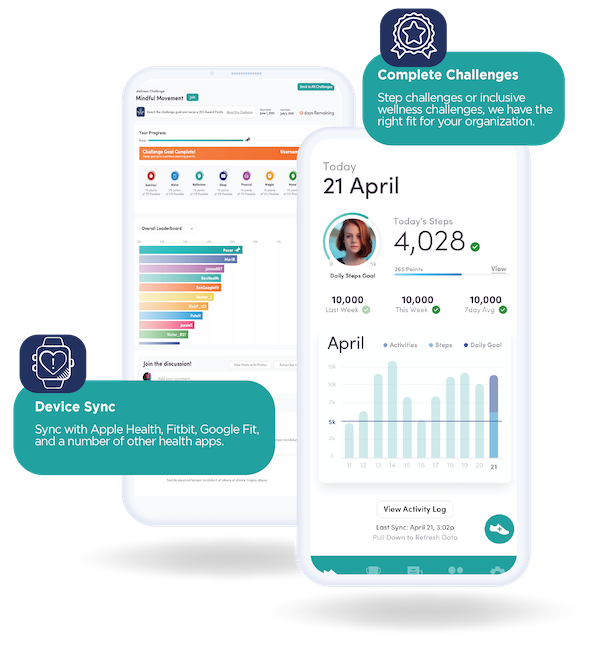May 18, 2023


May is Mental Health Awareness month! On the surface, it may feel like mental health doesn't overlap with the workplace, but you may want to think again. We may be living in a post-pandemic world, but that doesn't mean we're not still affected by it.
In fact, the WHO reported a 25% worldwide increase in anxiety and depression in March of 2022. Pair this with 52% of workers saying they're feeling burned out, and one thing's for sure: American workers are struggling with their mental health.
Because of this, companies are beginning to learn how to utilize employee wellness programs in the workplace.
Here, we’ll take a look mental health in the workplace. We'll explore how to support mental health in the workplace, and how to talk about mental health at work.
What Is Mental Health?
Mental health can dictate how we feel, think, and act. It encompasses psychological, social, and emotional wellbeing.
It's also not static. Mental health is fluid, changing throughout our lives in response to biological or external factors. Our brain chemistry, life experiences, and family history all have an impact on our mental health.
When someone’s mental health is well, they’ll likely feel content. They'll be able to socialize, work, and cope with stressors effectively.
Conversely, poor mental health may result in a withdrawal from others, a lack of interest or joy in activities they once liked, and a feeling of being constantly on edge.
If these feelings persist, it may become a diagnosable mental health disorder. Anxiety, depression, and obsessive-compulsive disorder are a few of the most common mental health conditions:
-
- Anxiety: Generalized anxiety disorder (GAD) is among the most common mental health disorders in the United States. It includes symptoms of persistent worrying, being on edge, intense fear of failure, and fear of everyday interactions.
-
- Depression: Depression is another common mental health disorder, characterized by feelings of hopelessness, a loss of interest in activities previously enjoyed, sleeping too much or too little, and feeling regularly fatigued.
-
- OCD: Obsessive-compulsive disorder (OCD) involves invasive, intrusive thoughts that repeat throughout the day. These thoughts can cause harm and irritation in someone’s life.
- Eating disorders: Eating disorders can be characterized by an unhealthy relationship with food, which threatens emotional and physical health. Types of eating disorders include anorexia nervosa, bulimia nervosa, and binge eating disorder.
Whether it’s a stressful life event, a traumatic situation, or a pre-existing condition, everyone will likely experience a dip in their overall mental health at some point in their lifetime. When these times come, it’s important to remember that there is treatment and help available.
What Is Mental Health in the Workplace?
People spend a lot of time at work. So, it makes sense to make mental health a priority not just outside of work but also inside the workplace. Plus, maintaining respect for mental wellness will benefit employees and employers alike.
How Mental Health Affects the Workplace
The cost of poor mental health in the workplace can be detrimental to a business. If employees are experiencing mental health disorders they’ll likely struggle in multiple areas. They may struggle to communicate effectively, be productive, or be able to focus - let alone be fully engaged employees.
They could miss days of work, suffer from physical ailments, or they may even quit. These factors can take a toll on these individuals, your team, and the growth of your company.
It's important to remember, mental health isn't like diabetes or heart disease. Meaning, it's not something that only affects some people. Instead, think of it more like the flu - it will likely affect everyone at some point in their lives.
So, rather than only working with certain people's mental health, it's more effective to build a work culture that's mental health-friendly.
5 Ways to Promote Mental Health in the Workplace
Supporting mental wellness in the workplace helps struggling employees get the help they need. But it can also help promote a healthy work culture and foster employee engagement.
1. Physical Well-Being
Mental and physical wellness go hand in hand. Mental health can have a large impact on our wellbeing, resulting in a weakened immune system and frequent illness.
Likewise, a lack of exercise and a poor diet can contribute to a declining mental state. So, employers could be sure to provide options for employees to get exercise during the day.
You could:
- Create a fitness group that works out together after work
- Organize a friendly exercise competition for a month
- Install a gym inside the office
- Hold yoga sessions or light workouts to keep employees sharp and alert throughout the day
- Provide healthy lunches during the week — salads, fruits, and other healthy options can all help improve wellness.
Regular exercise and a healthy diet are some of the best ways to boost mental health. Find ways to instill the importance of physical wellness in the workplace.


RELATED: Workplace Wellness Activities: 16 Ways to Support Employee Wellbeing
2. Social Connections
Isolation and loneliness can be damaging to someone’s physical and mental health. So much so, the Centers for Disease Control found that poor social relationships was not only associated with increased anxiety, depression, but a 29% increased risk of heart disease and a 32% increased risk of stroke as well.
So, companies should strive to create a culture of belonging and inclusion at work.
For example:
- Create group activities: Yoga or workout groups are a great way to get people together while also improving their physical wellbeing.
- Recognition Culture: Hold meetings to let people know — individually and as a team — how their work is driving results and helping people other than themselves.
- Volunteer: Studies have shown that spending time in service to others creates a sense of meaning and offers stress-reducing effects.
When you build a culture of belonging and acceptance, you can make employees more satisfied with where they’re working, which, in turn, will help your company flourish.
RELATED: The DEI and Mental Health Connection (and Why It Matters)
3. Mental Health Education
One of the main barriers to many people achieving effective mental health is education — a lot of us simply lack the tools and knowledge needed to make a change. Consider providing tools in your workplace like:
-
- Wellbeing coaches: Sometimes, people want to start the path toward wellbeing and wellness — they’re just lacking adequate resources. A wellbeing coach can teach people how to try to maintain a healthy lifestyle and prioritize their mental health.
-
- Training modules: Many companies have started onboarding training that also includes education about mental health — identifying common issues like imposter syndrome and coping strategies can help employees start off on the right track.
- Apps: There are also a variety of mental health apps that allow employees to take notice of how they’re feeling. Many of these apps are simple yet effective — simply identifying emotions can have far-reaching benefits, like understanding the reasons behind those emotions, better control of our lives, and improved relationships with others.
Providing resources and tools and holding workplace mental health programs can help people uncover what may be troubling them. When they understand their own feelings and emotions better, they may be able to get the help they need and develop strategies to live satisfying lives.
4. Mindfulness and Meditation
The benefits of mindfulness and meditation have become clearer in recent years. When practiced, they significantly decrease anxiety, reduce implicit age and race bias, help treat and prevent depression, and improve cognition.
Building a mental health program for employees that includes mindfulness and meditation can have a significant impact on the workplace.
Here are a few ways to bring mindfulness into the workplace:
- Hold daily breath work or meditation practices
- Create a separate room for meditation to emphasize employees’ mental health at work
- Try Terryberry's wellness app to track mindfulness metrics and progress
5. Build a Positive Working Environment
Building a positive workplace culture is one of the most effective ways for promoting mental health in the workplace. A positive culture is also a great way to grow your company — more than ever, employees are viewing workplace culture as one of the driving factors in the job search. Over three-quarters of job searchers consider company culture before applying somewhere, so developing a positive one is key.
There are a few ways you can start building a positive culture:
- Train management and educate them about the importance of mental health.
- Create guidelines that explain how the office should run with regard to acceptance and respect.
- Create programs with a work-life balance in mind, as well as health insurance options with mental health included.
Figuring out how managers can support employees’ mental health can be challenging. But emphasizing physical well-being, social connections, mental health education, meditation, and building a positive work culture can help.
Some tools provide comprehensive programs that take all of these wellness aspects into account.
Terryberry offers an employee wellness program that allows employees to track their fitness, mood, mindfulness, sleep, and more while also connecting with one another through social feeds.
Talk About Mental Health in the Workplace
One of the biggest obstacles for many people when it comes to mental wellness is the stigma involved. In many families and cultures, being vulnerable is seen as a weakness. In truth, being able to express how you feel and identifying your struggles only makes you a stronger person.
In recent years, the importance of mental health has become clear and people all over are finding their own paths to wellness and breaking the stigma involved with mental health.
One of the best paths for people to get the help they need is through honest conversations with others who want the best for them. We’re entering a new era where the workplace can offer that for many people — you can create a space where employees can feel safe to discuss how they’re feeling, reduce stress, and find a way toward recovery.
Find times to discuss with your employees why it’s important to focus on mental health and refer them to mental health resources at work.
A business is only as good as its employees — investing in emotional wellbeing in the workplace is a win-win that helps everyone involved. You’ll find mental health solutions for employers and employees alike.
Support Employee Wellbeing with Terryberry
Understanding why mental health is important and knowing how to promote mental health and wellbeing is essential to running a successful business. To promote wellness, you need to find the right tools that can make your strategies effective.
Terryberry is dedicated to empowering organizations and their employees to live healthy and fulfilling lives. We offer a comprehensive app that allows employees to track fitness, mood, sleep, nutrition, mindfulness, and other wellness metrics.
Employees can even connect via the platform and motivate each other, creating an effective way to help promote wellness in the workplace. Contact us today to learn more!


